Tamron AF 18-270mm F/3.5-6.3 Di II VC PZD Review

Introduction
The Tamron AF 18-270mm F/3.5-6.3 Di II VC PZD is a 15x optical zoom lens designed for crop sensor DSLRs. Boasting features such as Piezo Drive focusing motor which - Tamron say - gives faster and more precise focusing and a restructured image stabiliser to fit into a smaller, lighter body, the Tamron 18-270mm f/3.5-6.3 DiII VC PZD costs around £399.95 and is available in Canon, Nikon and Sony fit. The Sony model comes without the VC image stabiliser because Sony cameras have it already built into the camera body.
Ease of Use
It's been well documented that professional photographers aren't all that keen on zoom lenses. But what about the amateur photographer who can't afford a lot of expensive prime lenses or someone that wants to go on holiday and enjoy the convenience of a wide zoom range without the bulk of half a dozen lenses. That's where the Tamron AF 18-270mm F/3.5-6.3 Di II VC PZD comes in. The lens has been reworked from its predecessor and is now slightly smaller, 24% to be precise, while the filter thread has also been decreased from a professional level 72mm to a more affordable 62mm.
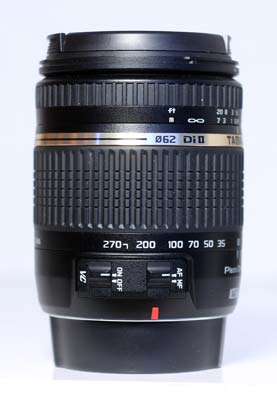 The Tamron AF 18-270mm F/3.5-6.3 Di II VC PZD lens
The Tamron AF 18-270mm F/3.5-6.3 Di II VC PZD lens
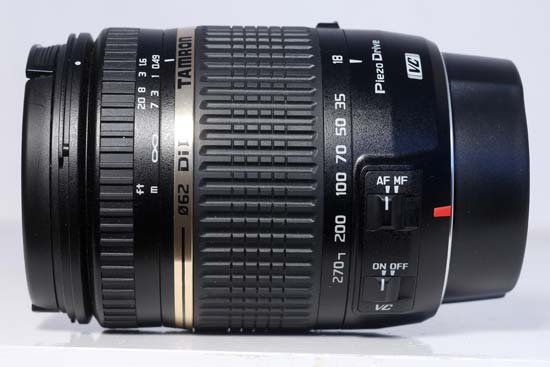 The Tamron AF 18-270mm F/3.5-6.3 Di II VC PZD lens
The Tamron AF 18-270mm F/3.5-6.3 Di II VC PZD lens
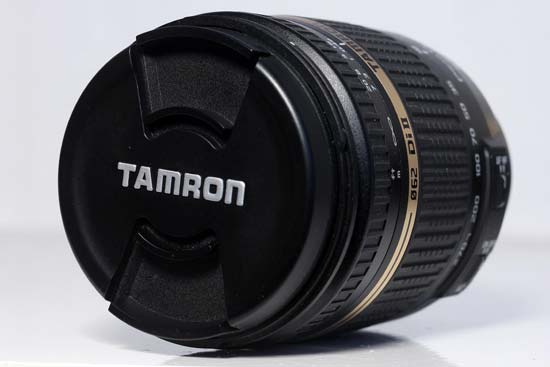 Front of the Tamron AF 18-270mm F/3.5-6.3 Di II VC PZD lens
Front of the Tamron AF 18-270mm F/3.5-6.3 Di II VC PZD lens
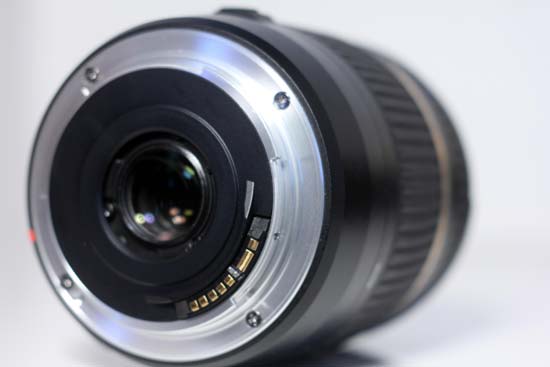 Rear of the Tamron AF 18-270mm F/3.5-6.3 Di II VC PZD lens
Rear of the Tamron AF 18-270mm F/3.5-6.3 Di II VC PZD lens
This new version of the lens is also 100g lighter rolling in at 450g. It certainly doesn't feel weighty in the hand. It is balanced though, which is important. The rear element is surrounded by a metal lens mount and hides 16 elements in 13 groups. That's a lot of glass for the image to go through and is under continuous threat of dispersion. There are seven aperture blades for the aperture range which has a minimum of f/22-f/40.
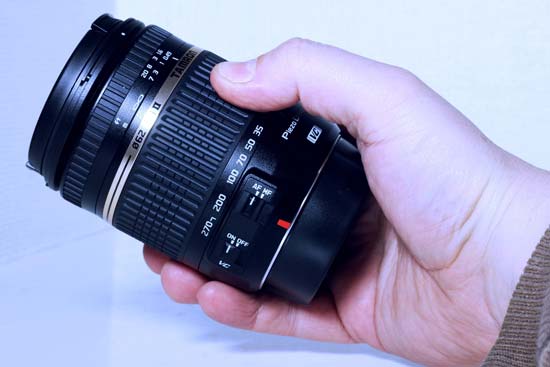 The Tamron AF 18-270mm F/3.5-6.3 Di II VC PZD lens in-hand
The Tamron AF 18-270mm F/3.5-6.3 Di II VC PZD lens in-hand
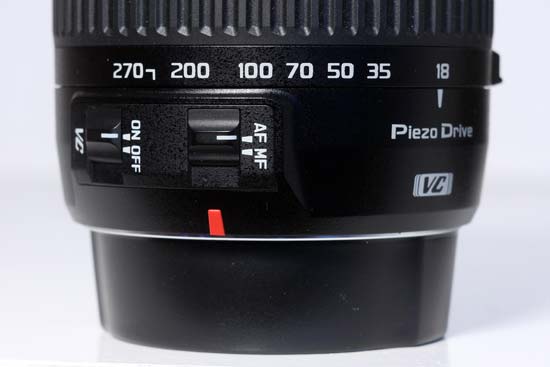 The side of the Tamron AF 18-270mm F/3.5-6.3 Di II VC PZD lens
The side of the Tamron AF 18-270mm F/3.5-6.3 Di II VC PZD lens
Towards the back of the Tamron AF 18-270mm F/3.5-6.3 Di II VC PZD lens are three switches. The first is a simple lock to keep the lens at 18mm by placing the switch into a carved divot in the barrel. At 18mm we didn't experience any lens creep but we did get it from just after the 35mm mark when the lens has come out a sufficient amount.
The other two switches are to toggle the AF/MF and VC on/off. VC is Tamron's version of an image stabiliser. It works very well in the Tamron AF 18-270mm F/3.5-6.3 Di II VC PZD lens. It's an active type that will visibly steady the shot in the lens for you to see. It does that for around a second after you've locked focus before resetting. Tamron claim that the new VC system is lighter and smaller thanks to a complete reversal in how the system operates. Usually IS uses magnets attached to the IS lens element with electromagnetic coils. The new system is attached directly to the lens element.
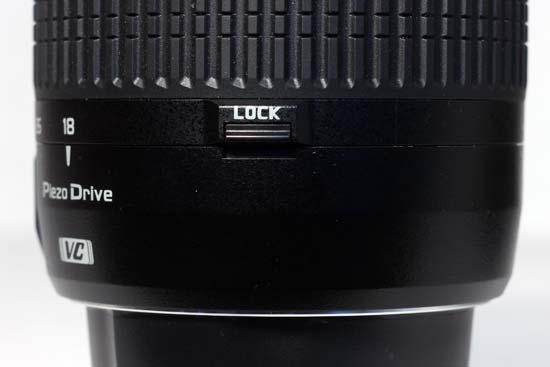 The side of the Tamron AF 18-270mm F/3.5-6.3 Di II VC PZD lens
The side of the Tamron AF 18-270mm F/3.5-6.3 Di II VC PZD lens
The Tamron AF 18-270mm F/3.5-6.3 Di II VC PZD does have a form of ultra-sonic motor. It incorporates a Piezoelectric motor that uses an electric charge to rotate the tip by producing an ultrasonic vibration. This in turn adjusts the rotor using friction. This type of ultrasonic focusing is distinctly smaller than other varieties meaning that there's less space being used. Focusing is certainly silent and precise but we didn't think it was as fast as a Canon USM lens.
 The Tamron AF 18-270mm F/3.5-6.3 Di II VC PZD's lens-hood
The Tamron AF 18-270mm F/3.5-6.3 Di II VC PZD's lens-hood
Focal Range
The focal range of the Tamron AF 18-270mm F/3.5-6.3 Di II VC PZD is extremely broad. It's possible to encompass a large amount of photographic styles when using a lens such as this. At 18mm, the field of view is 75°, which is the same as that of a 27mm lens on a 35mm full-frame camera.
 Field of view at 18mm
Field of view at 18mm
At the 270mm end, the angle of view is 6°, which is the same as that of a 405mm lens on a 35mm full-frame camera.
 Field of view at 270mm
Field of view at 270mm
Zooming
At wide-angle, the Tamron AF 18-270mm F/3.5-6.3 Di II VC PZD's zoom ring offers extra resistance than at other times. This is likely to prevent zoom creep and it works. It also doesn't move when being jiggled but this could change over time. At 18mm there's a locking button which can be used to keep the lens in place if this starts to happen.
Zooming action is smooth with no stepping. The action is all internal so there's no rotating of the front element. This is great for landscape photographers who use graduated filters because the filter won't rotate when the zoom is moved.
Focusing
The Tamron AF 18-270mm F/3.5-6.3 Di II VC PZD does have a form of ultra-sonic motor. It incorporates a Piezoelectric motor that uses an electric charge to rotate the tip by producing an ultrasonic vibration. This in turn adjusts the rotor using friction. This type of ultrasonic focusing is distinctly smaller than other varieties meaning that there's less space being used. Focusing is certainly silent and precise but we didn't think it was as fast as a Canon USM lens.
Focusing is precise and we didn't really have any trouble with finding our target. Focusing speed is pretty good but we found that it would find the subject then wait a second or so before confirming with the double beep.
If, like us, you're old and have trouble using the manual focus, the autofocus is very precise. We found that using manual focus, we had to switch to live view and zoom into the image using the screen on the back of the camera.
Chromatic Aberrations
The Tamron AF 18-270mm F/3.5-6.3 Di II VC PZD does suffer from chromatic aberration, more so at the edges of the frame when shooting wide-angle.
 |
 |
 |
 |
Light Fall-off
With the Tamron AF 18-270mm F/3.5-6.3 Di II VC PZD wide open at f/3.5, you can see some very noticeable light fall-off in the corners throughout the zoom range. Stopping down helps, although to completely get rid of this phenomenon, you will need to use an f-stop of f/8 or smaller.
 Vignetting at 18mm
Vignetting at 18mm
 Vignetting at 270mm
Vignetting at 270mm
Macro
Tamron state on the website that the AF 18-270mm F/3.5-6.3 Di II VC PZD has 49cm macro focusing. We think it was actually closer, more like 30-40 centimetres. It varies depending on the focal length but at 18mm, it's not worth doing. Let's face it, this isn't a macro lens and it doesn't even have a macro setting. However, the close-up shot of a memory card that we took is sharp and - considering that specification - is pretty close.
 Close-up performance
Close-up performance
Bokeh
Bokeh is a word used for the out-of-focus areas of a photograph, and is usually described in qualitative terms, such as smooth / creamy / harsh etc. In the AF 18-270mm F/3.5-6.3 Di II VC PZD lens, Tamron have employed an iris diaphragm with seven rounded blades, which has resulted in quite nice bokeh in our view. We do realise, however, that bokeh evaluation is subjective, so we've included some 100% crops for your perusal.
 |
 |
 |
 |
Sharpness
In order to show you how sharp this lens is, we are providing 100% crops on the following pages.
